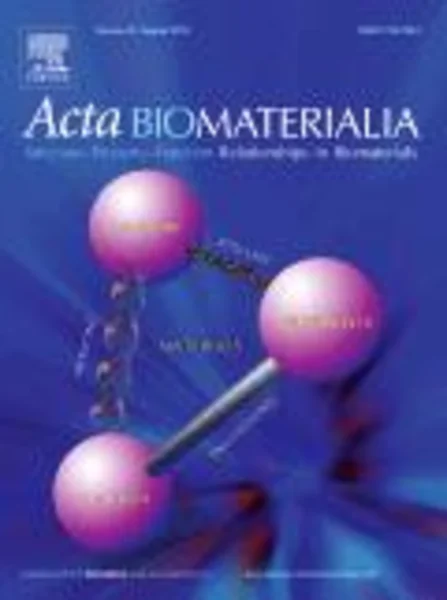-
biodegradable nanocomposite hydrogel structures with enhanced mechanical properties prepared by photo-crosslinking solutions of poly(trimethylene carbonate)–poly(ethylene glycol)–poly(trimethylene carbonate) macromonomers and nanoclay particles
جزئیات بیشتر مقاله- تاریخ ارائه: 1392/01/01
- تاریخ انتشار در تی پی بین: 1392/01/01
- تعداد بازدید: 844
- تعداد پرسش و پاسخ ها: 0
- شماره تماس دبیرخانه رویداد: -
soft hydrogels with elasticity modulus values lower than 100 kpa that are tough and biodegradable are of great interest in medicine and in tissue engineering applications. we have developed a series of soft hydrogel structures from different methacrylate-functionalized triblock copolymers of poly(ethylene glycol) (peg) with poly(trimethylene carbonate) (ptmc) by photo-crosslinking aqueous solutions of the macromonomers in 2.5 and 5 wt.% colloidal dispersions of clay nanoparticles (laponite xlg). the length of the ptmc blocks of the macromonomers and the clay content determined the physicomechanical properties of the obtained hydrogels. while an increase in the ptmc block length in the macromonomers from 0.2 to 5 kg/mol resulted in a decrease in the gel content, the addition of 5 wt.% laponite nanoclay to the crosslinking solution lead to very high gel contents of the hydrogels of more than 95%. the effect of ptmc block length on the mechanical properties of the hydrogels was not as pronounced, and soft gels with a compressive modulus of less than 15 kpa and toughness values of 25 kj m−3 were obtained. however, the addition of 5 wt.% laponite nanoclay to the formulations considerably increased the compressive modulus and resilience of the hydrogels; swollen nanocomposite networks with compressive modulus and toughness values of up to 67 kpa and 200 kj m−3, respectively, could then be obtained. the prepared hydrogels were shown to be enzymatically degradable by cholesterol esterase and by the action of macrophages. with an increase in ptmc block length in the hydrogels, the rates of mass loss increased, while the incorporated laponite nanoclay suppressed degradation. nanocomposite hydrogel structures with a designed gyroid pore network architecture were prepared by stereolithography. furthermore, in the swollen state the porous gyroid structures were mechanically stable and the pore network remained fully open and interconnected.
مقالات جدیدترین رویدادها
-
استفاده از تحلیل اهمیت-عملکرد در ارائه الگوی مدیریت خلاقیت سازمانی و ارائه راهکار جهت بهبود
-
بررسی تاثیر ارزش وجوه نقد مازاد بر ساختار سرمایه شرکت های پذیرفته شده در بورس اوراق بهادار تهران
-
بررسی تأثیر سطح افشای ریسک بر قرارداد بدهی شرکت های پذیرفته شده در بورس اوراق بهادار تهران
-
بررسی تأثیر رتبه بندی اعتباری مبتنی بر مدل امتیاز بازار نوظهور بر نقد شوندگی سهام با تأکید بر خصوصی سازی شرکت ها
-
تأثیر آمیخته بازاریابی پوشاک ایرانی بر تصویر ذهنی مشتری پوشاک ایرانی (هاکوپیان)
-
نقش مسئولیت پذیری (با نگرش اسلامی) و امیدواری در پیش بینی رضایت از زندگی نوجوانان
-
طراحی چارچوب مدیریت ریسک های تأمین مالی پروژه های ساختمانی
-
مدیریت فروش و سفارشات در شرایط اختلال زنجیره تأمین
-
بررسی عددی پایداری گودها با زوایای مختلف میخکوبی در شرایط اشباع و غیر اشباع
-
شهر فرهنگ قشم زمینه ساز همبستگی و اعتلای فرهنگی
مقالات جدیدترین ژورنال ها
-
مدیریت و بررسی افسردگی دانش آموزان دختر مقطع متوسطه دوم در دروان کرونا در شهرستان دزفول
-
مدیریت و بررسی خرد سیاسی در اندیشه ی فردوسی در ادب ایران
-
واکاوی و مدیریت توصیفی قلمدان(جاکلیدی)ضریح در موزه آستان قدس رضوی
-
بررسی تاثیر خلاقیت، دانش و انگیزه کارکنان بر پیشنهادات نوآورانه کارکنان ( مورد مطالعه: هتل های 3 و 4 ستاره استان کرمان)
-
بررسی تاثیر کیفیت سیستم های اطلاعاتی بر تصمیم گیری موفق در شرکتهای تولیدی استان اصفهان (مورد مطالعه: مدیران شرکتهای تولیدی استان اصفهان)
-
بررسی مولفه های تفکر استراتژیک در مدیران شرکت گاز استان خوزستان به وسیله مدل جین لیدکا
-
عوامل موثر در افزایش جرم و بزهکاری از دیدگاه اسلام
-
تاثیر چابک سازی فرآیندها در بهره وری سازمانی واحدهای صنعتی با در نظر گرفتن نقش میانجی تفکر استراتژیک ( مطالعه موردی صنایع کوچک و متوسط شرکت شهرک های صنعتی استان تهران )
-
investigating the environmental properties and energy consumption of geopolymer concrete as a sustainable material
-
building exoskeletons for the integrated retrofit of social housing




سوال خود را در مورد این مقاله مطرح نمایید :